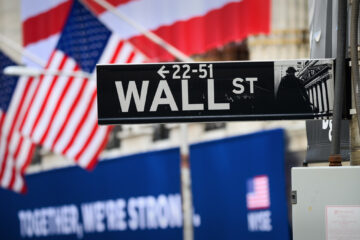Make no mistake: The stock-market rally that erupted after Donald Trump’s win in the presidential election was powerful.
The major averages surged to new record closes. The Standard & Poor’s 500 Index and the Dow Jones Industrial Average hit new closing highs and enjoyed their best weeks since the last week of October 2023.
💰💸 Don’t miss the move: SIGN UP for TheStreet’s FREE Daily newsletter 💰💸
The Nasdaq Composite’s 5.74% gain was its best weekly performance since early September.
Related: What’s next for student loan forgiveness after Trump win
Moreover, the index managed to stay above 19,000 on Friday for a second day in a row. Meanwhile, the S&P 500 briefly topped 6,000, and the Dow reached as high as 44,157 before dropping back to 43,989.
The week ahead is busy and includes:
Two important inflation readings.Earnings from three Dow components: Home Depot (HD) (Tuesday): Cisco Systems (CSCO) (Wednesday); Walt Disney DIS (Thursday).
But the economic and earnings reports this week and the Federal Reserve’s rate cut on Thursday offer no internal threats to markets. The major averages are not overbought.
And there are no obvious external threats that could derail stocks, especially not the calendar. So, the situation now suggests the easiest direction is up for now.
That’s why brokerages are boosting targets for the S&P 500 well above 6,000.
November (and December) are very good months
Every year, starting about now, you hear about the Santa Clause rally.
Technically, it should occur in the final five trading days of the year and the first two days in January.
But since the idea was coined by the late Yale Hirsch, the idea of Santa Claus Rally has come to mean something that starts in early December.
It is true that stocks usually move higher in November and December, and it’s happening now.
In other words: Happy Holidays.
In fact, November is the start of the best six-month period for U.S. stocks, according to the Stock Trader’s Almanac, started by Hirsch in 1968.
November has been the best month for the S&P 500 and second best for the Dow since 1950. It has been the second best month for the Nasdaq Composite Index since since 1971.
Plus: Tech stocks have been booming all year. Nvidia (NVDA) , is up 11% just in the first six trading days of November. For all of 2024, it’s risen 198%. It’s also the most valuable company in the world.
Related: AMC sees tailwinds from blockbuster movies, but one problem lingers
Oil prices are flat to lower. West Texas Intermediate, the benchmark U.S. crude, finished the week at $70.38 per 42-gallon barrel. That’s down nearly 20% since the 2024 peak of $87.67 on April 12.
Retail gasoline prices have been falling steadily since April as well.
And the Federal Reserve has all but promised a benign interest-rate environment for the foreseeable future because, as Chairman Jerome Powell said at Thursday’s news conference, “If you look at the U.S. economy, its performance has been very good. And that’s what we hear from businesspeople, an expectation that that will continue.”
Caveats to rosy scenario
Mortgage rates are still relatively high. Home prices are even higher. The rate on a 30-year mortgage on Friday was at 6.98%, according to Mortgage News Daily.
While the rate is down from 7.1% earlier in the week and and 8% in October 2023, adding huge amounts of housing, similar to what happened after World War II is expensive because of zoning and high prices for land and building. So, home sales have been stuck, especially in the largest markets, for at least two years.
Home-sales analysts believe mortgage rates need to drop to 6% or lower to really get home sales to move.
Related: Mortgage rate changes loom amid Fed rate cuts & Trump presidency
Wall Street is betting a new Trump administration means less regulation
The rally that broke after Tuesday’s election for now is (less about economic or market certainty. )
Rather, it’s built on the expectation that the very conservative Republican Party will be able influence economic development almost directly. The expectation also assume:
Interest rates will move lower. (Which the Fed wants.)Market regulation will ease substantially.More tariffs on imports will be imposed.Environmental rules will be loosened.Rising isolationism in U.S. means America’s global footprint will shrink.
The tariff question is not known because the new administration has not begun to formally a plan. China may be the most important target.
That aside, deal makers, banks and investment houses, especially, are delighted and expect to see a new wave of mergers sweeping the economy.
More Economic Analysis:
Jobs report shocker puts Fed interest-rate cut in playFed inflation report renews pressures, tests interest rate betsFed interest rate decision and election may roil stocks
Investors agreed financial companies will gain in this environment. Wall Street giants Goldman Sachs (GS) and Morgan Stanley (MS) were up 13.5% and 12.7%, respectively, on the week. Goldman Sachs was the Dow’s top performer, followed by Nvidia’s 9%.
The S&P 500 Financial Sector overall added 5.2%, fourth best among the 11 S&P 500 sectors, after Consumer Discretionary, Energy and Industrials.
The Information Tech Sector was up “only” 5.2%.
Elon Musk, CEO of Tesla Inc., and President-elect Donald Trump before a campaign event this past summer.
A battle brewing over the Fed?
A wild card in the regulation issue: Tesla (TSLA) CEO Elon Musk, now close to President-elect Trump, last week endorsed the idea of letting presidents intervene on Federal Reserve policy.
Trump has said he thinks he should have a say in Fed interest-rate policy.
The Fed has been run as an independent agency since 1951 when the Treasury Department and the Fed agreed to let the Fed be in charge of setting domestic interest rates.
Last week, Fed chair Jerome Powell was asked if he would resign if Trump asked. Powell’s response: “No.”
The week’s big economic reports
These are the Consumer Price Index report, due Wednesday, and the Producer Price Index report, Thursday,
The first is expected to show inflation up 0.2%, or around 2.5% over the last 12 months. The PPI’s gain is projected at perhaps unchanged, but core PPI may come at 3.2% year over year.
Also coming: the monthly small business optimism report from the National Association of Independent Business, also Tuesday; the weekly on jobless claims, due Thursday, and a retail sales report on Friday.
Earnings reports to watch
The big reports are:
Home Depot, (HD) . due Tuesday before the open. The current earnings estimate: $3.64 a share, up from $3.81 a year ago. Revenue estimate: $39.1 billion, up 4% from a year ago. Home Depot shares: Up 17.1% in 2024.
Occidental Petroleum (OXY) , due Tuesday. Earnings estimate: 81 cents a year, off about 30% from a year ago. Revenue estimate: $7.47 billion, up 1% from a year ago. Warren Buffett’s Berkshire Hathaway (BRK.A) owns 28% of the shares. Occidental share price: Down 15.4% in 2024.
Cisco Systems (CSCO) , first quarter fiscal 2025 earnings due Wednesday. Earnings estimate:89 cents a share, down 0.22% from a year ago. Revenue estimate: $14.05 billion, down 4.24% from a year ago. Cisco shares: Up 14.9% in 2024.
Walt Disney (DIS) , fiscal fourth-quarter results. due Thursday. Earnings estimate: $1.10, up 34% from a year ago. Revenue: $22.44 billion, up 5.6% from a year ago. Disney shares: Up: 9.7% in 2024.
Related: Veteran fund manager sees world of pain coming for stocks


